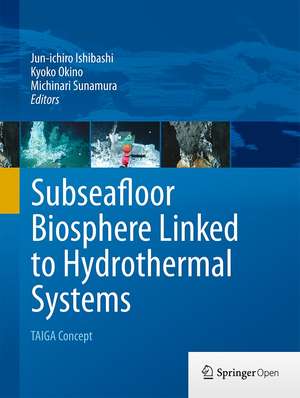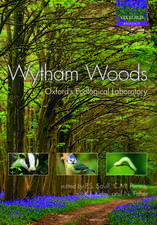Subseafloor Biosphere Linked to Hydrothermal Systems: TAIGA Concept
Editat de Jun-ichiro Ishibashi, Kyoko Okino, Michinari Sunamuraen Limba Engleză Hardback – 29 ian 2015
| Toate formatele și edițiile | Preț | Express |
|---|---|---|
| Paperback (1) | 455.53 lei 38-44 zile | |
| Springer – 8 oct 2016 | 455.53 lei 38-44 zile | |
| Hardback (1) | 505.65 lei 3-5 săpt. | |
| Springer – 29 ian 2015 | 505.65 lei 3-5 săpt. |
Preț: 505.65 lei
Nou
Puncte Express: 758
Preț estimativ în valută:
96.77€ • 100.41$ • 80.88£
96.77€ • 100.41$ • 80.88£
Carte disponibilă
Livrare economică 24 februarie-10 martie
Preluare comenzi: 021 569.72.76
Specificații
ISBN-13: 9784431548645
ISBN-10: 4431548645
Pagini: 170
Ilustrații: XVIII, 666 p. 372 illus., 235 illus. in color.
Dimensiuni: 210 x 279 x 32 mm
Greutate: 2.4 kg
Ediția:2015
Editura: Springer
Colecția Springer
Locul publicării:Tokyo, Japan
ISBN-10: 4431548645
Pagini: 170
Ilustrații: XVIII, 666 p. 372 illus., 235 illus. in color.
Dimensiuni: 210 x 279 x 32 mm
Greutate: 2.4 kg
Ediția:2015
Editura: Springer
Colecția Springer
Locul publicării:Tokyo, Japan
Public țintă
ResearchCuprins
Introduction: concept of TAIGA.- Geochemical constraints on potential biomass sustained by subseafloor water-rock interactions.- Microbial cell densities, community structures, and growth in the hydrothermal plumes of subduction hydrothermal systems.- Systematics of distributions of various elements between ferromanganese oxides and seawater from natural observation, thermodynamics, and structures.- Evaluating hydrothermal system evolution using geochronological dating and biological diversity analyses.- Quantification of microbial communities in hydrothermal vent habitats of the Southern Mariana Trough and the Mid-Okinawa Trough.- Development of hydrothermal and frictional experimental systems to simulate sub-seafloor water–rock–microbe interactions.- Experimental hydrogen production in hydrothermal and fault systems: Significance for habitability of subseafloor H2 chemoautotroph microbial ecosystems.- Experimental assessment of microbial effects on chemical interaction between seafloor massive sulfides and seawater at 4℃.- A compilation of the stable isotopic compositions of carbon, nitrogen, and sulfur in soft body parts of animals collected from deep-sea hydrothermal vent and methane seep fields: variations in energy source and importance of subsurface microbial processes in the sediment-hosted systems.- Tectonic background of four hydrothermal fields along the Central Indian Ridge.- Indian Ocean hydrothermal systems: seafloor hydrothermal activities, physical and chemical characteristics of hydrothermal fluids, and vent-associated biological communities.- Petrology and geochemistry of mid-ocean ridge basalts from the southern Central Indian Ridge.- Petrology of peridotites and related gabbroic rocks around the Kairei-hydrothermal field in the Central Indian Ridge.- Distribution and Biogeochemical Properties of Hydrothermal Plumes in the Rodriguez Triple Junction.- Vent fauna in the Central Indian Ridge.- The mantle dynamics, the crustal formation, and the hydrothermal activity of the Southern Mariana Trough back-arc Basin.- Seismic structure and seismicity in the Southern Mariana Trough and their relation to hydrothermal activity.- Electrical resistivity structure of the Snail site at the Southern Mariana Trough spreading center.- Asymmetric seafloor spreading of the southern Mariana Trough back-arc basin.- Geochemical characteristics of active backarc basin volcanisms at the southern end of Mariana Trough.- Mineralogical and geochemical characteristics of hydrothermal minerals collected from hydrothermal vent fields in the Southern Mariana spreading center.- Dating of hydrothermal mineralization in active hydrothermal fields in the Southern Mariana Trough.- Intra-field variation of prokaryotic communities on and below the seafloor in the back-arc hydrothermal system of the Southern Mariana Trough.- Vent fauna in the Mariana Trough.- Population history of a hydrothermal vent-endemic snail Alviniconcha hessleri in the Mariana Trough.- Hydrothermal activity in the Okinawa Trough backarc basin -geological background and hydrothermal mineralization-.- Active rifting structures in Iheya Graben and adjacent area of the mid-Okinawa Trough observed through seismic reflection surveys.- ESR dating of barite in sea-floor hydrothermal sulfide deposits in the Okinawa Trough.- Fluid geochemistry of high-temperature hydrothermal fields in the Okinawa Trough.- Sediment‒pore water system associated with native sulfur formation at Jade hydrothermal field in Okinawa Trough.- Comparative investigation of microbial communities associated with hydrothermal activities in the Okinawa Trough.- In situ determination of bacterial growth in mixing zone of hydrothermal vent field on the Hatoma Knoll, Southern Okinawa Trough.- Vent Fauna in the Okinawa Trough.- Brief report of side-scan sonar observations around the Yokoniwa NTO massif.- Examination of volcanic activity: AUV and submersible observations of fine-scale lava flow distributions along the Southern Mariana Trough spreading axis .- Brief report of side-scan sonar imagery observations of the Archaean, Pika, and Urashima hydrothermal sites.- The Yoron Hole: the shallowest hydrothermal site in the Okinawa Trough.- The Irabu Knoll: Hydrothermal site at the eastern edge of the Yaeyama Graben.- Tarama Knoll: Geochemical and biological profiles of hydrothermal activity.- Petrography and geochemistry of basement rocks drilled from Snail, Yamanaka, Archean, and Pika hydrothermal fields at the Southern Mariana Trough by Benthic Multi-coring System (BMS).- Pore fluid chemistry beneath active hydrothermal fields in the mid-Okinawa Trough: Results of shallow drilling by BMS during TAIGA11 cruise.- The characteristics of the seafloor massive sulfide deposits at the Hakurei Site in the Izena Hole, the Middle Okinawa Trough.- Occurrence of hydrothermal alteration minerals at the Jade hydrothermal field, in the Izena Hole, mid-Okinawa Trough.- Geochemistry of hydrothermal fluids collected from active hydrothermal systems in the southern Mariana Trough backarc spreading center.- Gamma ray doses in water around sea floor hydrothermal area in South Mariana.- 226Ra-210Pb and 228Ra-228Th dating of barite in submarine hydrothermal sulfide deposits collected at Okinawa Trough and South Mariana Trough.- OSL dating of sea floor sediments at the Okinawa Trough.- Immediate change of radiation doses from hydrothermal deposits.- Periodic behavior of deep sea current in the Hatoma Knoll hydrothermal system.- The gelatinous macroplankton community at the Hatoma Knoll hydrothermal vent.
Textul de pe ultima copertă
This book is the comprehensive volume of the TAIGA (“a great river ” in Japanese) project. Supported by the Japanese government, the project examined the hypothesis that the subseafloor fluid advection system (subseafloor TAIGA) can be categorized into four types, TAIGAs of sulfur, hydrogen, carbon (methane), and iron, according to the most dominant reducing substance, and the chemolithoautotrophic bacteria/archaea that are inextricably associated with respective types of TAIGAs which are strongly affected by their geological background such as surrounding host rocks and tectonic settings. Sub-seafloor ecosystems are sustained by hydrothermal circulation or TAIGA that carry chemical energy to the chemosynthetic microbes living in an extreme environment. The results of the project have been summarized comprehensively in 50 chapters, and this book provides an overall introduction and relevant topics on the mid-ocean ridge system of the Indian Ocean and on the arc-backarc systems ofthe Southern Mariana Trough and Okinawa Trough.
Caracteristici
Is the first synthesis of hydrothermal sites both in arc–back-arc and mid ocean ridge settings Presents an overview as well as original work to enhance understanding Delivers all results of the comprehensive TAIGA project at a glance Provides first-hand data in electric supplementary material(s) Targets researchers not only in oceanology but in wide fields (biology and earth science) Covers diverse study fields for synthetical understanding of subseafloor processes Includes supplementary material: sn.pub/extras










